See conditions for 51 failures here.
Sidekicks and Trackers: USA and some Canada models follow these rules.
Only USA cars trip 51's. Not others country cars.
EGR failure 1989 to 1995.
Smog man fails you for illegal NOX emissions?
Code 51 DTC or Engine won't idle correctly or EGR main diaphagm is dead. or Code 53?
Gen. 1 in a USA perspective.
Some Vitara's, Sunrunneres, Santana's have no EGR, nor any EGRT. Some have no EGR, CAT or O2 sensor at all like the JDM Vitara's.
Some Cars, like the ones in Canada, have no code DTC 51s tests at all..
Some Canadians, forget that their car, is a USA, car, (see hood tag? bingo) Here is a real Canada car.
Some Canada cars are Graymarket cars (who knows what?, open hood read tags, bingo)
You are here because the engine stalls full time or stalls just before, arriving at a stop light/sign. (EGR stuck open)
There are error DTC 51 detection systems, Calif and Federal , see hood sticker or this data.)
See Drawing #1
See parts ID. 1, 2,5, 11b (right) below.
If your car has the I.D. #2 the EGRT sensor , below, then it is a CALIF car. This sensor has just 2 pins.
The USA Federal car has no part #2 EGRT , it uses the MAP sensor vacuum readings and RPM to check for a working EGR.
There are really just 3 basic tests, the stall , bark and live test. (or just needs cleaning)
Part #1 When you press with finger on #1 diaphragm the motor fails to stall, (or near) (hot motor at 800 RPM idle drops to 500 or less.!)
I always use a hand vacuum tool at the EGR main vacuum nipple., so i can conduct this test and a classic diaphragm leak down test.
Flash Video's:
Here is man, using his vacuum tool (hidden) to do the stall test, (see the RPM drop hard and motor shake violently (misfiring)
The stall is subjective, only a real tachometer tells you the RPM the dash gauge, is a very poor tach. (really its a toy that warns of redline)
Mine drops to 400 RPM with my hand held opical Tachometer. And shakes like a wet dog...(gross misfiring)
TEST LOGIC:
FIRST DO A STALL TEST ! , if fails?, then do a bark test.
If stall works, then do the live test.
If bark test fails see my slide show for the reasons and paths.
If the the stall passes and bark passes then do the live test.
Most DTC Code 51 failure cause stalls at traffic lights.
These old cars have a basic system.
See Drawing # 1 below:
Hose 27 is EGR ported vaccuum , its dead until you advanced the throttle.
Hose 22/ 28 is hard plenum vacuum to the dash pot and MAP
Hose 44 is hard vacuum for EVAP.
Parts variances , Calif and Fed 48.:
The EGRT is just a thermoprobe , thermister device.
The FED car and Calif cars have different ECU's and software for the EGR monitors.
Part #2 is the Calif only EGR thermo probe sensor
This system , just like all 89 to 98 systems , has the exhaust originate from the #4 exhaust port and then pass through the rear head tunnel.
The EGR exhaust gases pass through the head to the rear of the intake manifold.
This gas then reaches the EGR mail valve #1 above.
This Valve can open and allow the gases to pass in to the intake plenum.
Overview:
There are many failure modes to this system, but the most common, is the clogging of the passages.
If the car will not idle correctly (low idle or stalling at traffic signals) or the Check engine lamp flashes, code 51, then we need to take the following actions.
Do all the 3 tests or?
- Clean the EGR MAIN part #1.
- Remove it and clean it with
Carb cleaner spray. Make sure the internal return spring drops the valve closed each
time, and is not stuck open with carbon chunks.
- Once clean? do a stall test. (below)
- If the stall test passes then the do the live test.
- (keep in mind most cars in 1993 (some start 94) and above you must have VSS (speed) above 0 MPH for Live test to function. (rear wheels must be turning)
If the stall test passes, do the live test. (stalls or near stall is PASS)
If the live test fails, you have bad EGR valves (mod valve or VSV bad or bad vacuum tubing). Missing CAT converter, or blow out rodded out CAT.
The EGR mod valve has a bottom tube, and it must bark running, if not clean EGR main, MOD valve port (a bark tube, if you will ?)
If the live test passes (and DTC51 remains) then look for restrictions, in the main exhaust path , or the EGR thermosensor #4 probe is bad or packed in carbon.
If the live test passes and DTC 51 remains and the car is a CAL car, check the thermoprobe, as per below. EGRT
I call the cars lacking the EGRT thermoprobe FED cars ( because the EGRT was INTRODUCED on Calif cars)
The FED uses the vacuum drop method , MAP changes to detect EGR ACTION. (if at all , many FED cars have no code 51 test)
The CAL uses the EGRT to detect the rise in exhaust temperature, as the EGR main opens,. (this is easy to see with any ohm meter scale ,running and pushing the diaphragm!)
The Thermoprobe (a NTC thermistor ) can be fool by using a 10000 ohm resistor in its place. ( 10k to 30k ohm is my guess for range ) that works on may years , Calif . based.
I've personally seen this TRICK work. on 1992. The ECU only looks 1 time for a HOT reading, EGRT. (a blissfully stupid ECU,to our benefit)
This trick can be used, to make sure there are no 51, while you block an EGR to test all other EFI function, then when engine runs perfect, I put the EGR back online.
The Stall test: best is with tools. A hand vacuum pump. (if brave ,use your finger here or a wooden stick to the metal rim seen below.)
Motor hot, 180F ( EGR fails of coolant is below 150F) and NOT OVERHEATED.
Must be idling at 800 RPM. All electric loads off, A/C off.
On this car , apply vacuum to the #1 main EGR valve nipple and hand pump it up to 8" inches of vacuum. (or press the diaphragm with your finger)
The RPM will drop radically , mine goes to 500 RPM or less and the engine shakes hard!. so must yours !
If the Main opens and the car don't come close to stalling or stall fully ,the exhaust path is blocked. Somewhere. see my slide show. Link 3 above.
While using the vacuum tool , do a diaphragm leak down test. (you are are there, its easy).
If you can not exercise the valve, then it is stuck or sticking, so remove it and clean it. or replace it as necessary. $100 part. at Rockauto.com.
If the valve is sticking open ( any) then it is bad or dirty ,there is a spring inside that forces it closed. If the valve does not snap back fast , it is bad.
If the stall test fails, then EGR MAIN below, is clogged or the paths to it and/or from it, are blocked. (carbon).
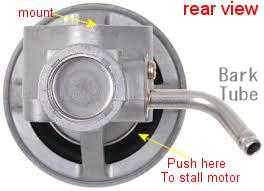
The Live test. (do not do this test until the above STALL test passes , or it's a waste of time)
See my new live test failed page here.
VSV = Vacuum Solenoid Valve.
A givenm is the stall test passes and so does the bark test.
- Get motor good and fully hot, well over 180deg.
F. Normal
hot motor is 180F to 195F ! range, The Thermostat must be functional ,
no
exceptions.
- Rev the motor up above 2500 RPM and the EGR Main
valve must move more and more
as RPM rises. The Diaphragm can be viewed easy on the 8v
motor. 16v with mirror.
- Starting in 1994 the EGR will not open unless the rear axle is moving (speed must not be zero) , this takes jacking up the rear axle, to do this test. (some 93's ?)
- The FSM shows using neutral and spinning the left
tire by hand (2 people, one at tire) and then do the Rev up live test.
(not required prior to 94)
- EGR MAIN #1 is stuck, clogged or the diaphragm is
cracked (do a leak
down test on the diaphragm) Stall test should fail.
- The VSV VALVE #11b is bad, see pointer at VSV in
photo.
(the other VSV, is cold fast idle dash pot VSV) VSV means Vacuum Solenoid Valve.
- The EGR Calif. thermo switch if fitted, REGTS #18 is stuck closed at
170deg
F or
more. Test it in a pan of hot water. (not found on FED48
cars until later in 1994 ,on)
- The vacuum hoses (any) are cracked or plugged up. (the whole
vacuum path from manifold nipple to EGR main nipple.)
- The vacuum schematic diagram is under the hood, look up ,
see large white sticker. (EPA compliance
sticker)
- The main Exhaust port is plugged up? no,. but is not packed, because the bark test passes.
- The Head tunnel is not packed because the bark test passes.
- The EGR ports in the intake manifold are plugged with carbon? (the EGR injection orifices can be clogged in the intake )No it is not packed, because the bark test passes.
- The Exhaust manifold has a clogged #4 EGR side port or is missing due to someone using non EPA Exh. manifold. No it is not packed, because the bark test passes.
- Cat Con is missing , making the EGR mod valve ,
fault. (it uses the 1-2 psi Cat back pressure to moderate EGR flow) This makes the EGR MOD useless.
- Dead VSS if car is 94 or newer. This will cause a DTC for
VSS , if true and CEL lamp will flash 51 and the VSS code 24.
- TPS signaling WOT (rare fail). EGR is dead near and at W.O.T. ( programmed). WOT = wide open throttle, VSS = veh. speed sensor.
- The engine is hot, 180F +
- Engine running, hot, driver in the seat ,at normal 800 RPM hot idle;
- The driver, moves the throttle off idle, the EGR port in the throttle body wakes up an send Vacuum to the EGR VSV
- The ECU then opens the EGR VSV and ported vacuum is sent to the MOD valve tube "P". (starting in 1994 the car must be moving, VSS faster than 0 miles per hour)
- The Modulator ,MOD for short , is pulsing madly in side with the Exhaust pulse via Tube 17. this pulsing increases with more engine, load, (driving).
- This MOD valve nipple "Q" sends this pulsing vacuum to the
EGR main and it opens and produces, EGR flows based on CAT back
pressure. end story.
If this fails, you can use a vacuum gauge to see if each step happens.
You could connect a vacuum line from a hard vacuum nipple hose 44 (take the EVAP off line) and use this nipple as a test hose.
Connect it, and pinch it, then the other end put on the EGR main (Q hose of) Start the engine, and unpinch the new 44 hose and it must stall.
Ok , that works so I put back the Q hose to the MAIN, and the new 44 hose to the MOD P nipple , yes remove the orig. P hose.
The engine is hot idle, and I unpinch the hose and see EGR main move, if it raise throttle the EGR moves farther.
I can then test the VSV this same way.
No need on pre 94 cars, but on 94 and newer, I put the 44 hose to EGR VSV vacuum input nipple, hose 27 removed, I race the throttle the VSV opens and the EGR main moves.
If not the VSV is bad. This allows me to test at 0 miles per hour on the newer car.
On the the newer cars, step 4 only happens above 0 miles per hour ,the VSS sensor must click,even dead slow. works..
Those are some tests there, with no tools.
I use a vacuum gauge to all this.
Keep in mind a cutted or missing cat will make the MOD valve dead. there will be no bark pulses at the MOD, tube B.
BARK TEST:
I made this up the test and name and saves tons of labor if it fails.
It's real simple (stall test failed so....)
First is the EGR main packed in carbon and blocked, or was and is now cleaned by you and working (test it by hand) then you do the bark tests.
- Main EGR valve removed. (if dirty clean it now)
- I block the EGR base vacuum hole in the intake EGR main
port one side sucks cranking, the other side barks. block the
suck side and then start the engine.
- I start the engine, and the EGR base exhaust port above, barks load ! GOOD I dont need to ream the head tunnel and/or the #4 exh port (COOL !)
- Make sure the small tube on the side of the EGR main, is
not packed full of carbon too.
- Take an rubber hose and try to blow in the vacuum hole in step 2, to see if the output side of the EGR main is not blocked.
- Now the stall test passes, after putting back the MAIN.
If you fail to block the intake vacuum suck hole in the intake EGR base, and start the engine the RPM will SCREAM! block it , or it will suck air and scream.
If the live tests passes, then suspect a bad EGRT (it must not be packed in carbon)
If the live test passes, then the ECU must be seeing errors from EGRT, is it missing? did the wires fall off it?
See Drawing 2 below, for all compenent ID's mentioned. #8 is the EGRT.
The California EGR REGTS coolant valve #14 (below) can be tested in a pan of hot water. for opening at 130F.
Open allows Vacuum to pass through valve. (it is either open or closed, this valve blocks EGR on a cold motor)
The EGRT Part #8 below, is what I call thermoprobe sensor and reads as follows: (ohmic resistance testing, unplugged)
THE EGRT, is screwed into the EGR main valve.
Data Points for the EGRT: source Pg, 6E99 FSM. ( has a graph plot and test procedure)
212° F. = 11.2 to 13.6k ohms or about 12,400 ohms ( boil it in water , measure the resistance with any ohm meter) (you can fool the 51 test by putting a 10,000 resistor here.
140° F = 42.1-55.5k ohms.
68° F = 214-313.8k ohms (typical room temperature reading)
The EGRT tested, in my Garage , right now, which is 45°F , reads 500k ohms. It is just a Thermistor ( with a reverse temperature coefficient. NTC)
Thermistors are just resistors that change value with temperatures ( Eg: just like ECT, IAT, but this one has different resistances)
The EGRT can be tested 2 ways:
1: Drop EGRT in a pan of hot water @212F boiling, or put the whole EGR main under water. (test it at room temperature first)
2: On car tests?, 1st do it at (outdoor cool temps,see data above) then hold open the main with a finger or vacuum tool and see resistance go below 10,000 ohms
If this passes , this test, the EGRT is good, (it is not a precision sensor, it is very crude) The ECU only looks for HOT for the code 51s.
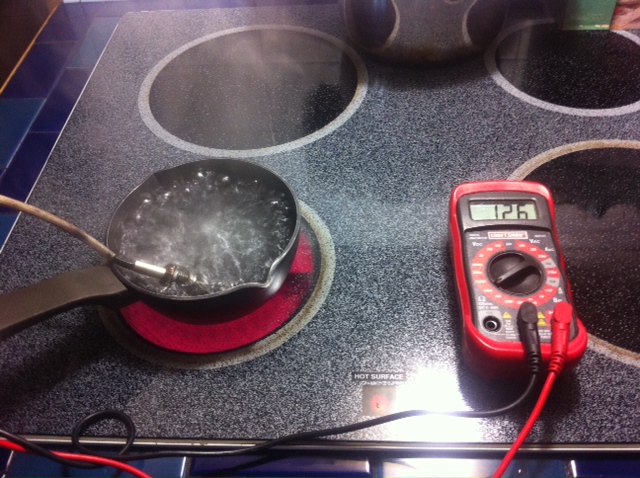
12.6K ohms, 12,600 ohms , passing the stove test. (wife hitting you rolling pin)
The Thermoprobe sensor:
What Kicks have the #4 dwg #1 California EGR thermo probe aka: EGRT.?
EGR Calif. matrix 89-95 ( USA) Suzuki Parts list derived.
All 94/95's 8v Cal or Federal tagged cars have EGRT.
All 8v 89 through 93 Calif cars.
Other 89 to 93 Federal Kicks have no EGRT.
GM GEO Tracker rules; (from my ufiche data)
8V:
EGRT is fitted to all 89 to 93 Cars. Calif. market. never on Fed cars.
EGRT is fitted to all 94/95s period.
On fed cars, with no EGRT , only vacuum and RPM is used to check EGR operation. (Code 51 monitors)
So , just make sure the STALL test passes, and it will be happy.
LIVE TESTING Failed, So the vacuum system must be bad, as shown below, in more tests.
The EGR uses ported vacuum from the throttle body, so there is no vacuum at idle only when raised off idle, do you get any vacuum.
\
Follow this procedure, to test the VSV valve if the live tests fail.
Last test , is the Modulator or EGR MOD. (later called a EGR Transducer in 1996)
See my sensor test page and video page here, see VSV tests at the end.
A Typical EGR functional map: Drawing 2: (Universal) Part 14 is only found on early 89's In later year the ECU knows water temp. at all times and does not need 14.
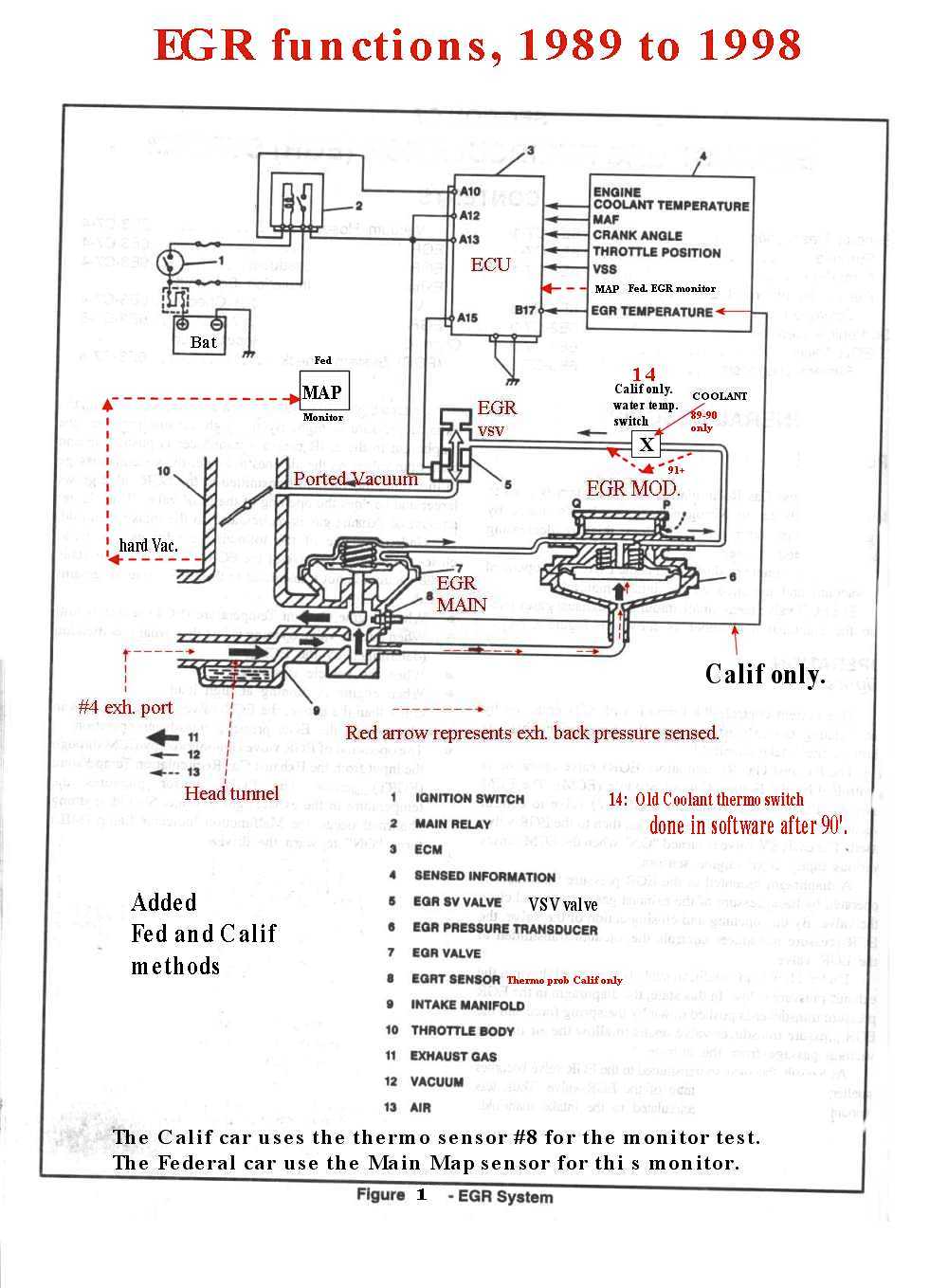
Photo /Drawing 3: ( must not stick ,spring must snap back fully the valve, must not be clogged, or cracked) note, the EGRT is missing below (FED stlye EGR)
The side port on the left below is the EGR MOD "bark" port, if it is clogged, the EGR mod will fail.
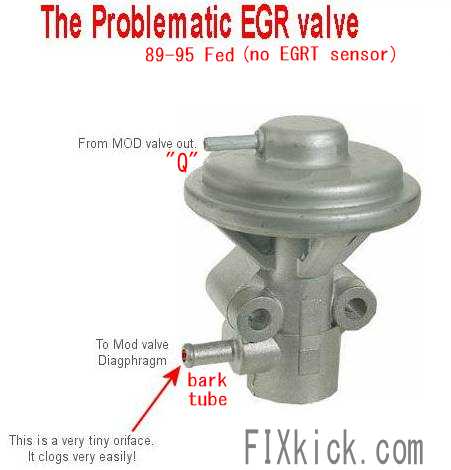 Side tube packed?,
Side tube packed?,BELOW Carbon choke point 2: (150k miles an no maintenance ) no words are necessary here, right? LOL !
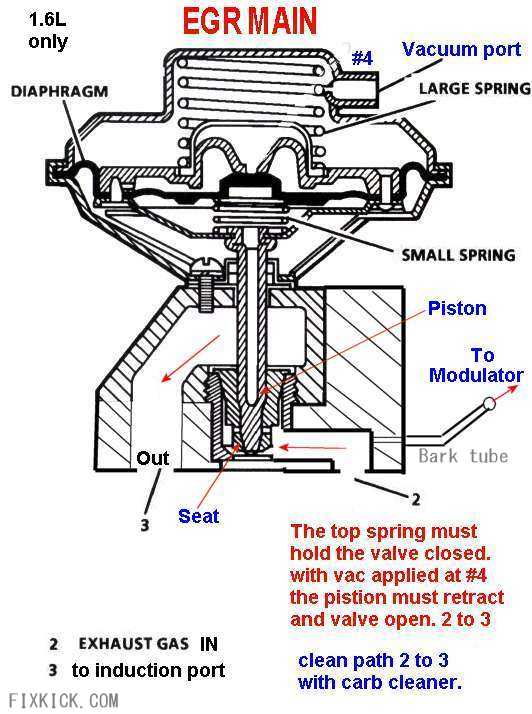
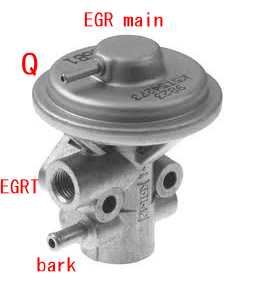 The threaded hole is for the EGRT. (Calif. sensors)
The threaded hole is for the EGRT. (Calif. sensors)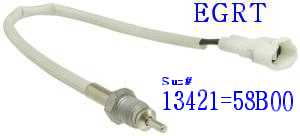 Calif only. (or may be on all 1995 cars)
Calif only. (or may be on all 1995 cars)Test Flow:
- Stall test.
- Bark test. (putt putt test ?)
- Live test.
- Component tests off car.
- if any thing fails, clean it and then test each part.
- Cleaning the EGR manifold passages is near the
last thing to try. (head tunnel and exhaust #4 flange port)
- Last is new parts.
On all years 89-98 , the MOD valve will malfunction, if the Exhaust Cat CONV is bad , rodded out, broken up or missing. Same with port #4 Exh. path
On some years 89-95 the ECU will drop to FAILSAFE mode and punish you with RICH and Retarded timing (power loss and horrible MPG) Calif cars only.
If the MAIN valve sticks on all cars made, the motor will run like crap and not idle at 800 but will be low.
CANADA LIST:
Sidekick, Vitara's , Sunrunners, Santana's and Tracker.
First you must now that they buy both US cars up in Canada or their own market E28 cars, and Gray Market cars back then, so only reading the body tags, reveals this big secret.
No CODE DTC 51 monitors or EGRT exists for:
89-91 1.6L engines. no DTC 51s Canada early years.
In 1995 the 8v 1.6L has a EGRT sensors and can throw Code 51s. in Canada.
Yes, all real Canada cars can have there own ECU's (see sticker on the ECU for Canada tag marks) USA is marked US MT or US AT ,check your ECU tag carefully.
ECU part number that must have a California EGR thermoprobe. Called EGRT
ecu SUFFIX PN. (see here for , bottom of ECU tag location)
(All other Suffix P/N , OEM suffix Part numbers, not listed below , are for vehicles not NEEDING the EGRT devices)
56B51 8V 94/95
56B61 8V 94/95
In fact most eary 8v Sidekicks can't throw code 51.
If you mix up the WRONG EGR valve , HARNESS OR ECU p/n then DTC CODE 51 will continue forever.
All other ECU P/N n are FED48, no EGRT probe.
The EGR if working lowers the exhaust valve temperatures cruising, making them last far longer ! and Arrests PING.
It is a friend today, unlike in 1979 ! IMHO ! hope my page helps, and your kick run forever.
Jargon is large here, sorry. but here is the list of Jargon.
Suzuki Name:
EGRT = EGR-Thermoprobe = EGR probe = Thermistor (electronic term) = Thermosensor. all are same device. #4 in drawing 1.
I have the conditions for causing DTC 51, in my 16valve MPI page.
rev.6 added , slide show for 8v only. and cheater resistor. added more photos 8-20-2014